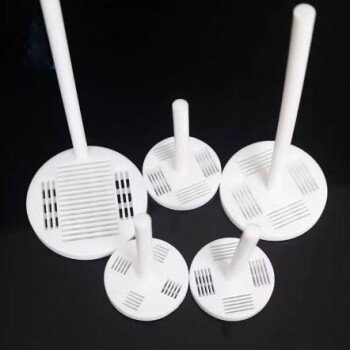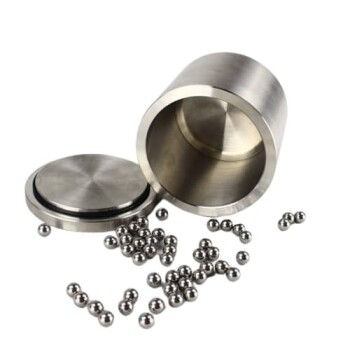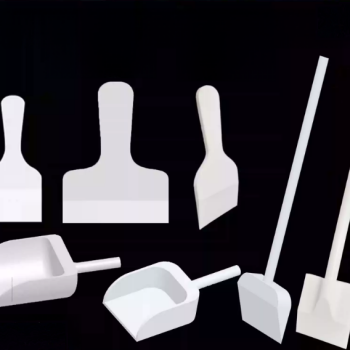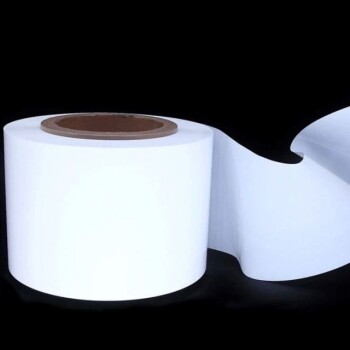塑料垃圾问题的三种主要解决方案是加强传统的机械回收,开发和扩大可生物降解的替代品,以及推进新型的化学回收和升级再造。每种方法都针对塑料生命周期的不同阶段,从改善我们处理现有垃圾的方式到从根本上改变我们使用的材料。
塑料垃圾的核心挑战不仅仅是处置问题;这是一个关于材料设计、消费和基础设施的系统性问题。没有单一的“万灵药”解决方案,有效的策略必须将减少我们的总体消费与多管齐下的方法相结合,以管理我们无法避免的垃圾。
解决方案 1:增强机械回收
机械回收是目前最成熟的塑料垃圾处理方法。它涉及物理上对塑料进行粉碎、清洗、熔化和重塑成用于制造的新颗粒。
机械回收的现状
这是大多数人最熟悉的过程——将塑料瓶放入回收箱。目标是将该瓶子重新变成可用材料,延长其寿命并减少对原生塑料的需求。
核心挑战:降级回收(Downcycling)
机械回收的主要限制是降级回收。每次塑料被熔化和再加工时,其聚合物链都会缩短,从而降低其质量和强度。这意味着一个透明的塑料瓶很少能变成另一个透明的塑料瓶;它更有可能变成地毯纤维或公园长椅等低等级产品。
改进的关键创新
为应对降级回收,目前的努力集中在更好的分拣和清洗上。人工智能驱动的光学扫描仪可以比人工分拣员更准确地识别和分离不同类型的塑料,从而减少污染。先进的清洗过程还可以去除更多杂质,从而获得更高质量的最终产品。
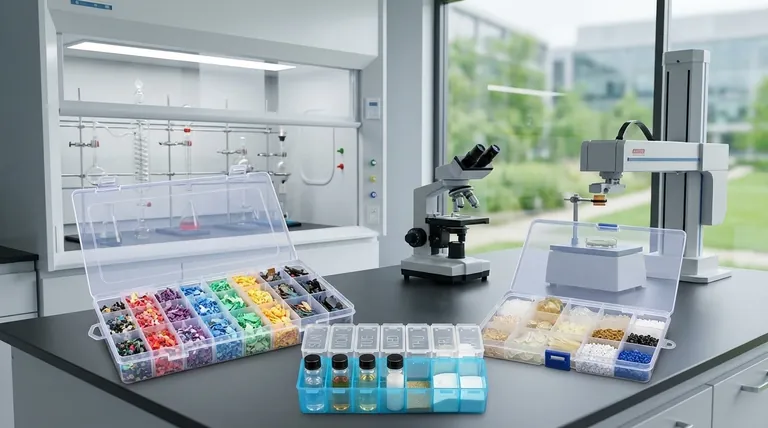
解决方案 2:开发可生物降解的替代品
这种方法侧重于用设计用于在环境中自然分解的材料来替代传统的石油基塑料。
生物塑料的潜力
生物塑料由玉米淀粉、甘蔗或藻类等可再生资源制成。最常见的例子是聚乳酸 (PLA),常用于一次性杯子和食品容器。目标是创造不会在环境中持续数个世纪的材料。
“可生物降解”的注意事项
一个关键的区别是,大多数“可生物降解”或“可堆肥”塑料在垃圾填埋场或海洋中不会分解。它们需要工业堆肥设施中特定的高温、高湿条件,而这些设施尚未普及。
污染的风险
如果像 PLA 这样的生物塑料被错误地混入传统塑料回收流程中,它们就会成为污染物。由于它们的化学成分和熔点不同,它们可能会毁掉一整批回收的石油基塑料,这凸显了清晰标签和消费者教育的必要性。
解决方案 3:推进化学回收和升级再造
化学回收是一系列新兴技术,它利用化学过程、热量或催化剂将塑料分解回其原始的分子构件。
将塑料分解成基础材料
像热解这样的过程在无氧环境下使用高温,将混合塑料垃圾转化为液态油或原始单体。然后,这些原材料可用于制造新的、原生质量的塑料,从而完全避免了降级回收的问题。
“升级再造”的潜力
一个更先进的概念是升级再造,旨在将低价值的塑料垃圾转化为高价值的材料。例如,研究人员正在利用工程酶和化学过程,将 PET(水瓶中的塑料)转化为有价值的工业化学品,甚至是香草醛(香草味的主要成分)。
理解权衡
没有一种解决方案是完美的,每种方案都有重大的挑战需要解决,才能在全球范围内发挥效力。
能源和基础设施差距
先进的机械分拣和化学回收都需要大量的能源和对新基础设施的大量投资。此外,扩大可生物降解替代品的规模需要建立一个平行的工业堆肥设施系统来正确处理它们。
根本原因:过度消费
从根本上说,回收和材料创新只解决了问题的“生命终结”部分。如果没有同时采取积极措施减少一次性塑料的生产和消费,这些解决方案将难以跟上所产生的巨大垃圾量。
为您的目标做出正确的选择
最佳的前进道路取决于结合这些策略来解决塑料垃圾危机的不同方面。
- 如果您的主要关注点是即时影响: 投资于改善现有的机械回收基础设施,并加强公共分类实践,以最大限度地提高现有材料的价值。
- 如果您的主要关注点是长期可持续性: 支持真正可生物降解的材料以及创造完全循环塑料经济所需的化学回收技术的发展和规模化。
- 如果您的主要关注点是系统性变革: 倡导优先考虑减少浪费的政策,让生产者对其产品的整个生命周期负责,并从一开始就消除一次性塑料的设计。
成功的未来取决于一个多方面的战略,该战略可以减少我们对塑料的依赖,改善我们管理塑料的方式,并创新我们材料的本质。
摘要表:
| 解决方案 | 核心理念 | 关键挑战 |
|---|---|---|
| 增强机械回收 | 物理粉碎和重塑现有塑料。 | 材料质量下降(降级回收)。 |
| 可生物降解替代品 | 用可自然分解的材料替代传统塑料。 | 需要特定的工业堆肥设施才能分解。 |
| 化学回收和升级再造 | 将塑料分解到分子水平,以创造新的、高质量的材料。 | 高能耗和对新的、大规模基础设施的需求。 |
通过 KINTEK 优化您的实验室在材料创新中的作用
应对塑料垃圾危机需要先进的研究和精确的材料分析。无论您是开发新的生物降解聚合物、优化回收工艺,还是探索化学升级再造途径,拥有合适的实验室设备对于成功至关重要。
KINTEK 专注于提供高质量的实验室设备和耗材,以支持您的可持续发展目标。我们提供您所需的工具来:
- 分析材料特性和生物塑料的降解率。
- 测试和优化化学回收和热解过程。
- 确保回收材料和新聚合物配方的质量控制。
让我们帮助您为材料科学的未来装备您的实验室。立即联系我们的专家,讨论我们的解决方案如何加速您的研究并为循环经济做出贡献。
图解指南
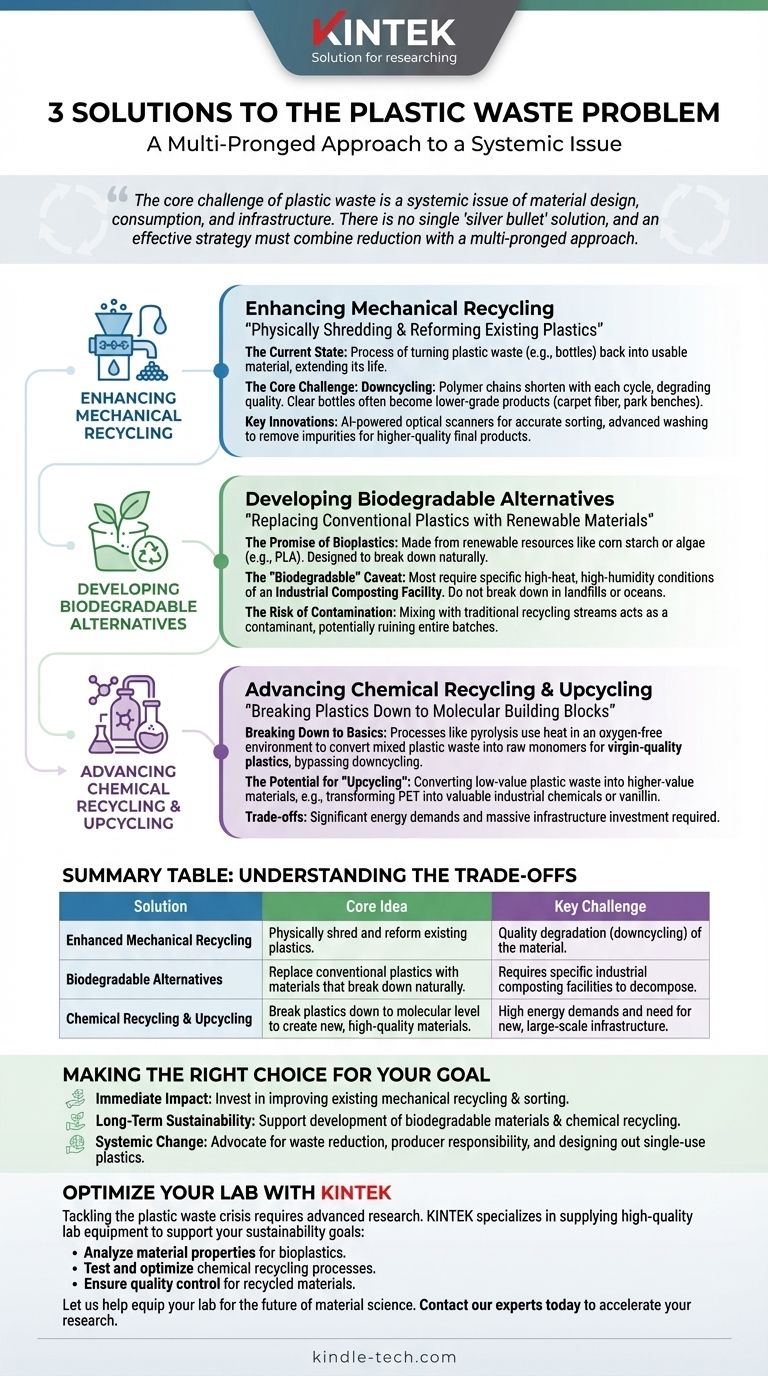
相关产品
- 电池实验室用纽扣电池收纳盒
- 定制加工和模塑PTFE特氟龙零件制造商,用于实验室ITO FTO导电玻璃清洗花篮
- 实验室球磨罐磨机,配有金属合金研磨罐和研磨球
- 清洗架定制PTFE特氟龙零件制造商
- 耐酸碱化学粉末材料定制PTFE特氟龙铲勺制造商

